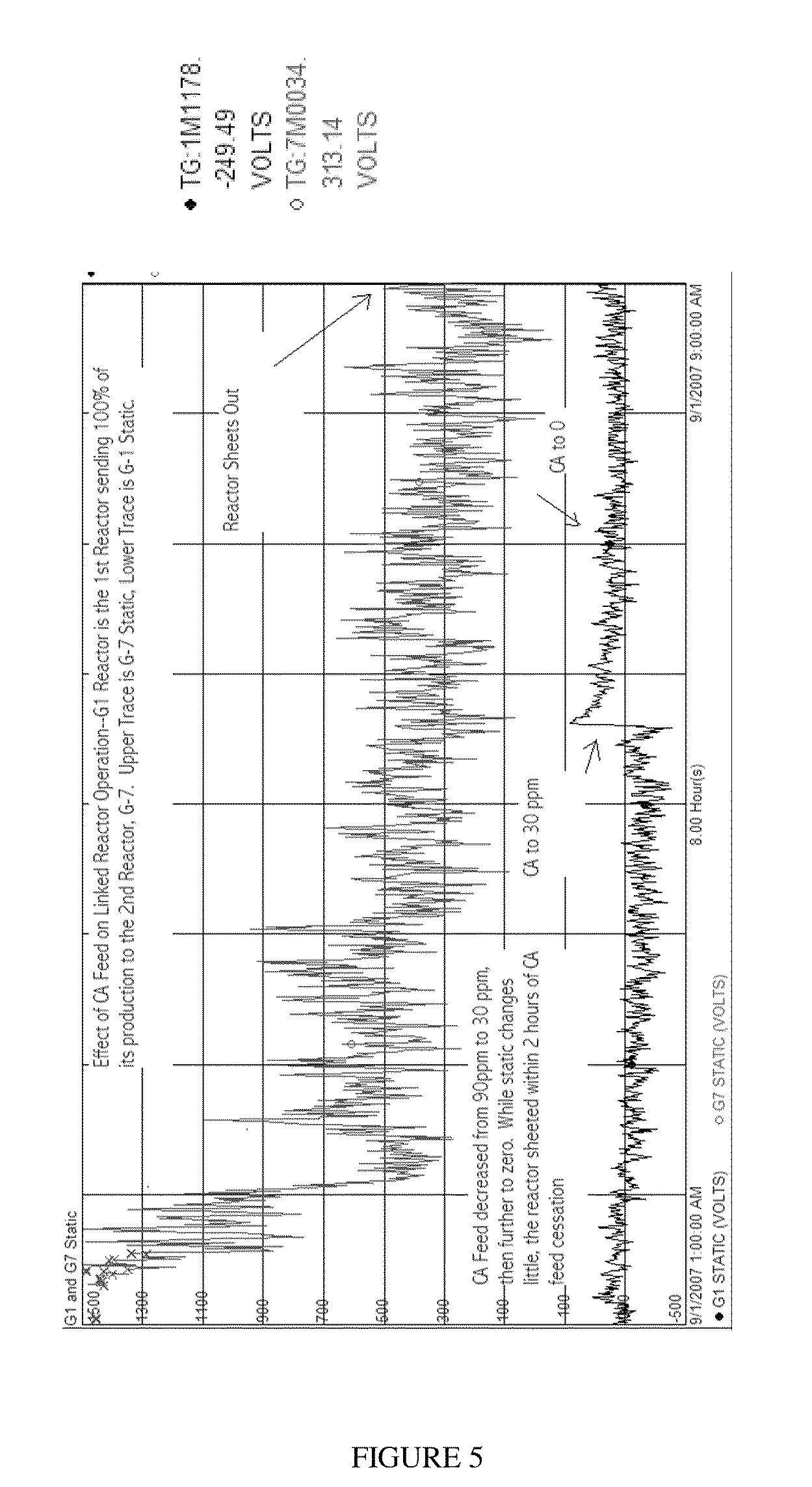Process for polymerizing olefin-based polymers
a technology of olefin and polymerization process, applied in the field of polymerizing olefin-based polymers, can solve the problems of premature reactor shutdown, poor control and eventual sheeting, and difficult production of these polymers with very high molecular weight resin fractions
- Summary
- Abstract
- Description
- Claims
- Application Information
AI Technical Summary
Problems solved by technology
Method used
Image
Examples
example 1 (comparative)
Polymerization Example 1 (Comparative)
[0261]The reactor was started using a pre-dried seed bed, in accordance with the following procedure. The reactor was a gas phase, fluidized bed is described in U.S. Pat. No. 6,187,866 and U.S. Pat. No. 6,617,405, each incorporated herein by reference.
[0262]The reactor was pre-dried with nitrogen purge to less than 20 ppmv water. Then approximately 120 pounds of seed bed (the gas phase reactor is pre-charged with a granular “seed” bed prior to startup to facilitate catalyst dispersion) was charged to the reactor. The polyethylene seed bed had been produced using a UCAT G-500 catalyst (available from Univation Technologies) and had a I21 of ˜30 and a density of 0.950 g / cc.
[0263]The reactor was dried at low pressure, until the moisture was below 10 ppm using a 90° C. jacket temperature on the heat exchanger. The reactor was pressurized with N2 to 150 psi. The trisiobutylaluminum (TIBA) (1400 cc; 2.5 wt % in isopentane solvent) was charged over a o...
example 2 (comparative)
Polymerization Example 2 (Comparative)
[0266]The reactor was restarted using a similar procedure as discussed above. Conditions were the same as above, with the exception that the ethylene partial pressure was initially set at 75 psi, and slowly lowered to 30 psi, after the reaction was established. The isopentane concentration was maintained at 15-16 mole percent. Catalyst feed was started at 4.0 cc / hour, and reaction was observed within one hour of commencement of catalyst feed. Reaction conditions were adjusted to produce polymer meeting specification requirements. Reaction conditions are shown in Table 6, and product properties are shown in Table 7.
[0267]Static was observed to increase to high levels, and reactor shutdown occurred due to blocked product discharge system, within 12 hours of the high static level. This result is shown in FIG. 2.
[0268]Static, especially when negative at levels of less than −1000 volts, generally lead to sheeting. In this case, values below −3000 wer...
example 5
Polymerization Example 5
[0279]The catalyst was prepared using the precursor composition of Catalyst Example 2, following the standard chlorination procedure given above. Chlorination was done using EASC at a final reaction temperature of 50° C. for 60 minutes. The “chlorine to ethanol” mole ratio, as added to the solid precursor composition, was two.
[0280]The reactor, which had been operating at steady state, was deliberately subjected to a discontinuation of catalyst feed. CA feed was maintained at a level sufficient to provide ˜20 ppm of CA in the reactor. The reactor temperature was maintained at 84° C., the H2 / C2 mole ratio was from 0.19 to 0.20, and the C6 / C2 mole ratio was from 0.0065 to 0.0068. The ethylene partial pressure was maintained at approximately 58 to 61 psia. The cocatalyst was TEAL, and isopentane was added to the reactor to maintain an inlet dew point from 74° C. to 76° C. The initial Al / Ti ratio was approximately 50. Cocatalyst feed was continued, after catalyst...
PUM
| Property | Measurement | Unit |
|---|---|---|
| Melt flow ratio | aaaaa | aaaaa |
Abstract
Description
Claims
Application Information
 Login to View More
Login to View More - R&D
- Intellectual Property
- Life Sciences
- Materials
- Tech Scout
- Unparalleled Data Quality
- Higher Quality Content
- 60% Fewer Hallucinations
Browse by: Latest US Patents, China's latest patents, Technical Efficacy Thesaurus, Application Domain, Technology Topic, Popular Technical Reports.
© 2025 PatSnap. All rights reserved.Legal|Privacy policy|Modern Slavery Act Transparency Statement|Sitemap|About US| Contact US: help@patsnap.com



